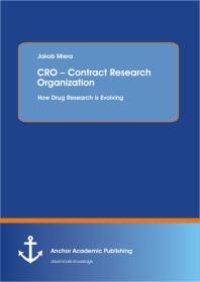
Ebook: CRO – Contract Research Organization: How Drug Research is Evolving: How Drug Research is Evolving
Author: Jakob Miera
- Tags: Pharmaceutical biotechnology -- Germany., Biopharmaceutics -- Economic aspects.
- Year: 2014
- Publisher: Diplomica Verlag
- City: Hamburg, GERMANY
- Edition: 1
- Language: English
- pdf
This book deals in general with mergers & acquisitions in the CRO industry, and more specifically with reasons for M&A, success factors during the M&A process, and why M&A can fail in the Contract Research Organization industry. The pharmaceutical industry faces increasing obstacles in respect to the development and introduction of new medications. That has to do with stricter requirements for admission and sharper controls by authorities. Today, the research and development of a new drug can easily consume more than $800 million and lasting between 10 and 15 years. Due to these facts pharmaceutical companies are looking for an alternative in the drug development process. A popular alternative is the outsourcing or in-house working with Contract Research Organizations (CRO). CRO are specialized in coordination and monitoring of drug development activities. The size of the CRO market in 2012 was around $32 billion and had an estimated market growth of around 9 – 12% for 2013. Increased outsourcing and allocation of R&D money towards CRO reflects a driving force for prospective growth. Contract Research Organizations consider mergers & acquisitions as a vital solution to achieve their objectives. Auszug aus dem Text Text Sample: Chapter 3.3, Managerial Motives: Managerial motives have a more psychological background. They are driven by the Hubris or the Agency-Hypothesis. 3.3.1, Hubris: Roll presented a study 1980s where he suggested that the hubris is an important motive for corporate takeovers. The interpretation of the empirical results is that manager’s pride and an exaggerated opinion of oneself could have a negative effect on the shareholders interests. Pure personal interests and not economic gains motivate the decision makers to undertake the takeovers. Due to the hubris managers could tend to pay a premium for a company that was correctly valued by the markets (assumption of strongly efficient markets). The hubris model is similar to the winner’s curse phenomenon in auctions and the irrational decisions can cause that the acquirer loose money on the acquisition. 3.3.2, Agency Hypothesis: Georgen and Renneboog outline that takeovers could be motivated by the agency hypothesis. This means that sheer self-interest of the acquirer is the main reason for the offer. Therefore, a conflict between the management (agents) and the shareholders could arise. Managers who are driven by this motive are mainly interested in takeovers that provide them additional power and prestige, whereas shareholders want a higher profitability and participate in higher stock profits. A study has shown that the corporation size is the main determinant for management salaries and bonuses and not the profitability. The difference to the hubris hypothesis is that here the managers will knowingly overpay the transactions to enjoy the mentioned personal advantages. As a result Morck, Shleifer, and Vishny pointed out that the pure self-interest could lead to many unprofitable mergers and acquisitions. 4., Success Factors for the Merger & Acquisitions process: First of all, this chapter illuminates an ideal Merger & Acquisition process. On that account the process is divided in three main phases. Subsequently, the components of each stage are presented. Afterwards the emphasis lies on the possible success factors of the phases. 4.1, Merger & Acquisitions Process: Generally, Mergers & Acquisitions are structured as a multilevel process. According to a PWC study a comprehensive structure is important to deal with the complex and multifarious challenges. Moreover, it enables the management to work highly efficient and more goal-oriented. There is no one-size fits all solution but the academic literature tries to develop models, which can be used as instruction. Basically, three main phases can be identified: Planning, Execution (Transaction), and Integration. The process is not static but rather dynamically and can be adapted to each M&A scenario concerning the company and industry characteristics. Additionally, there can be a lot of another factors (e.g. tax considerations, ownership-structure), which can have an influence on the configuration of the process.
Download the book CRO – Contract Research Organization: How Drug Research is Evolving: How Drug Research is Evolving for free or read online
Continue reading on any device:

Last viewed books
Related books
{related-news}
Comments (0)